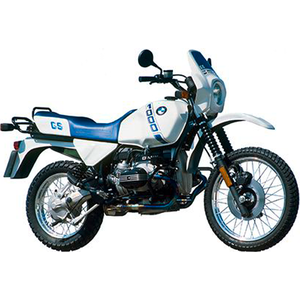BMW R 100 GS (1986–1996): The Adventure Icon That Redefined Exploration
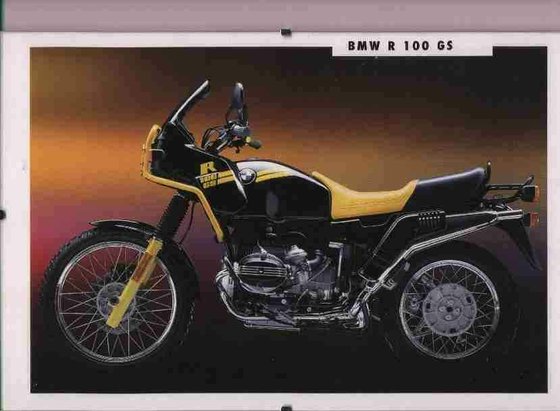
Introduction
There’s a certain magic to swinging a leg over the BMW R 100 GS. It’s not just the way its boxer engine rumbles to life, or how its tall stance commands attention at a café stop. It’s the knowledge that this machine, born in an era when “adventure motorcycling” was still a niche pursuit, helped define the genre itself. From 1986 to 1996, the R 100 GS combined Teutonic engineering with a spirit of wanderlust, earning its stripes in the Sahara Desert and on suburban commutes alike. Having spent a week with a well-preserved 1993 Paris-Dakar model, I can confirm: this isn’t just a motorcycle. It’s a passport to the road less traveled.
Design & Ergonomics: Form Follows Function
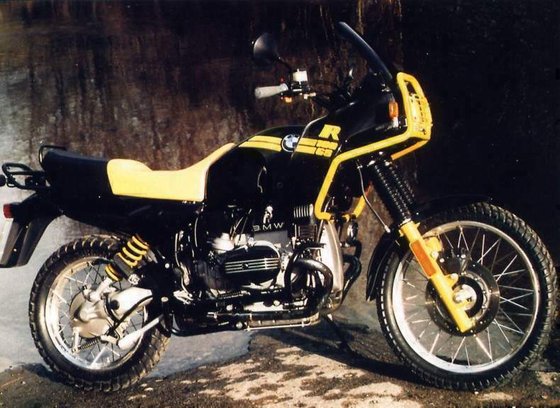
The R 100 GS’s design is a masterclass in purposeful aesthetics. Its horizontally opposed twin cylinders jut out like mechanical shoulders, giving the bike a distinctive silhouette. The 21-inch front wheel (90/90-21 tire) and high-mounted fender hint at off-road intent, while the bench-style seat (850 mm / 33.5 inches tall) strikes a balance between accessibility and ground clearance (200 mm / 7.9 inches).
BMW’s choice of a double-loop tubular frame with a bolt-on rear section wasn’t just about durability—it created a modular platform for accessories like crash bars and panniers. The Paris-Dakar variants added a gargantuan 35L fuel tank (8.1 US gal), extending range to over 500 km (310 miles) between fill-ups.
Riding position is upright and commanding, with wide handlebars offering leverage for technical terrain. The dashboard is spartan but effective: a speedometer, basic warning lights, and later models included a tachometer. Heated grips (optional) were a revelation in chilly mornings, a luxury in the pre-electronic-aid ‘90s.
Engine & Performance: The Soul of a Workhorse
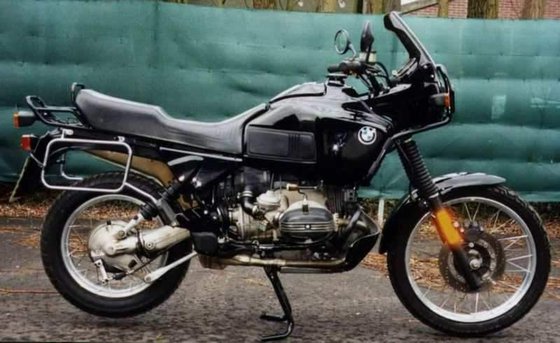
At its heart lies the air-cooled 980cc boxer twin, a design that traces its roots to the 1920s but refined for the modern era. With 60 hp (44 kW) at 6,500 rpm and a stump-pulling 76 Nm (56 ft-lbs) of torque at 3,750 rpm, this engine isn’t about peak numbers—it’s about character.
Throttle Response: Carbureted by twin 40mm Bing CV units, the GS delivers power with a linear, old-school charm. Crack the throttle at 2,000 rpm in third gear, and the bike surges forward with a baritone growl, unfazed by load or incline. The shaft drive adds a slight driveline lurch during aggressive acceleration, but the Paralever rear suspension (180 mm / 7.0 inches of travel) mitigates much of the dreaded “shaft jacking.”
Gearbox Quirks: The 5-speed transmission is robust but demands patience. Finding neutral at stoplights can feel like solving a Rubik’s Cube, and shifts are deliberate rather than snick-snick precise. Yet, once rolling, the tall gearing (1.50:1 in fifth) makes highway cruising relaxed at 120 km/h (75 mph), with the engine turning a lazy 4,000 rpm.
Real-World Speed: BMW claimed a top speed of 181 km/h (112 mph), but the GS feels most at home between 80–130 km/h (50–80 mph). The 210 kg (462 lbs) wet weight is noticeable when pushing hard, but the low center of gravity (thanks to the boxer layout) keeps it manageable.
On-Road Manners: The Gentleman Adventurer
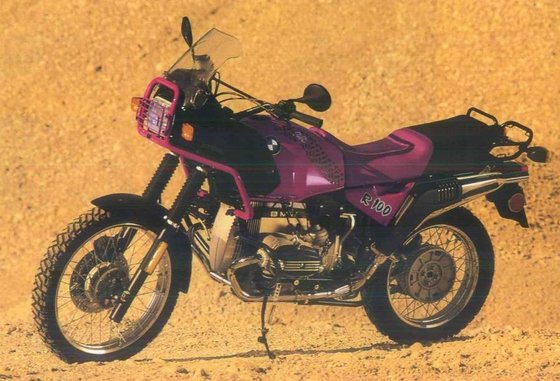
On pavement, the R 100 GS defies its adventure billing to deliver a surprisingly refined experience. The telescopic fork (225 mm / 8.8 inches travel) and Paralever rear soak up bumps with a plushness that shames many modern bikes. Steering is light at low speeds, aided by the narrow 90/90-21 front tire, yet stable enough to inspire confidence in sweeping corners.
Braking: The single 285mm front disc with a 2-piston Brembo caliper and 200mm rear drum are adequate but require planning. Stomp on the front lever, and stopping power is progressive rather than abrupt—a blessing on loose surfaces, but underwhelming during emergency maneuvers. Upgraded sintered pads (available at MOTOPARTS.store) are a wise investment.
Comfort: Hours melt away in the saddle. The seat is firm yet supportive, and the wind protection from the small fairing and handguards is effective up to 100 km/h (62 mph). For touring, add a taller screen and the iconic metal panniers.
Off-Road Capability: Better Than It Should Be
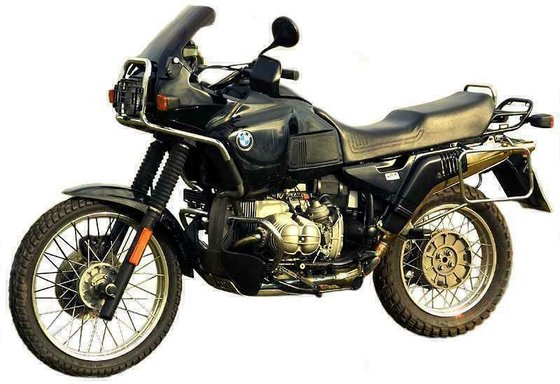
Let’s be clear: the R 100 GS is no dirt bike. At 210 kg (462 lbs), it’s a heavyweight in the dirt. Yet, it’s astonishingly competent for its size.
Sand & Gravel: The long-travel suspension and torquey engine make light work of fire roads. Keep momentum steady, and the GS floats over washboard surfaces. In deep sand, the weight becomes apparent—this isn’t a bike for dune bashing, but it’ll tractate through moderate off-road trails with patience.
Rocks & Ruts: Ground clearance (200 mm / 7.9 inches) and the bash plate protect the engine, though the protruding cylinder heads demand caution. The shaft drive eliminates chain maintenance but adds unsprung weight—stick to slower, technical sections.
Tire Choice: Original Metzeler Saharas (90/90-21 front, 130/80-17 rear) are versatile, but modern knobbies like Heidenau K60s transform off-road grip.
Competition: How the GS Stacks Up
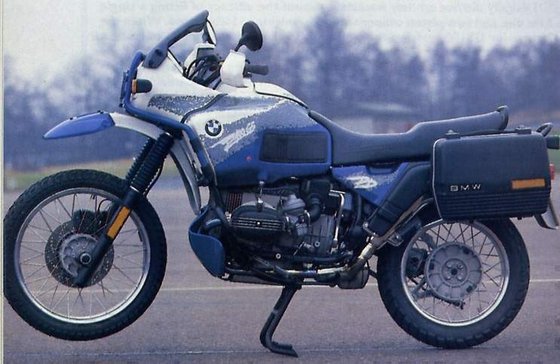
In the ‘80s–’90s, the R 100 GS faced rivals that challenged its dominance:
- Cagiva Elefant 900
- Power: 90° V-twin, fuel-injected, ~80 hp
- Weight: 207 kg (456 lbs)
-
Verdict: Faster and sharper, but plagued by reliability issues. The Elefant felt like a race bike; the GS was the trusty overlander.
-
Yamaha Super Tenere XTZ750
- Power: 749cc parallel-twin, 62 hp
- Weight: 224 kg (494 lbs)
-
Verdict: More off-road-focused but heavier. Yamaha’s build quality rivaled BMW’s, but the chain drive required more maintenance.
-
Honda Africa Twin XRV650
- Power: 647cc V-twin, 57 hp
- Weight: 207 kg (456 lbs)
- Verdict: Lighter and nimbler off-road, but lacking the GS’s highway composure.
The GS’s Edge: Shaft drive, lower seat height, and a dealer network that spanned continents. It wasn’t the best at anything—except going anywhere, repeatedly.
Maintenance: Keeping the Legend Alive
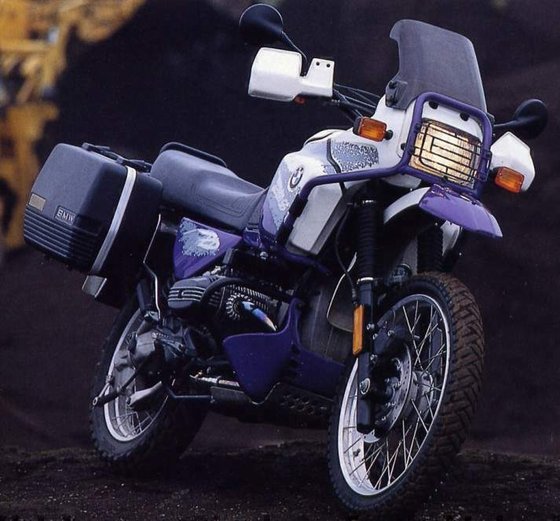
The R 100 GS’s air-cooled simplicity makes it a DIY favorite. Key considerations:
- Valve Adjustments: Every 10,000 km (6,200 mi). Cold clearances: intake 0.10 mm (0.004 in), exhaust 0.20 mm (0.008 in).
- Oil Changes: 2.5L of SAE 20W-50 (with filter). Use OEM filters to avoid oil starvation.
- Shaft Drive: Replace final drive oil (260ml SAE 90 GL-5) annually. Check for leaks at the Paralever pivot.
- Carb Sync: Essential for smooth idle. The Bing CV carbs respond well to ultrasonic cleaning.
- Brakes: Upgrade to DOT 5.1 fluid for firmer lever feel. Stainless steel brake lines (available at MOTOPARTS.store) improve response.
Common Upgrades:
- Progressive fork springs to reduce dive.
- LED lighting for better visibility.
- Aftermarket exhaust (though the stock muffler’s burble is iconic).
Conclusion: The Timeless Adventurer
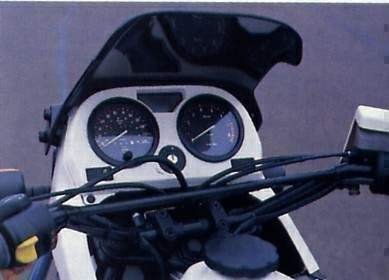
Spending time with the R 100 GS is like reconnecting with an old friend—one who tells stories of Dakar rallies and transcontinental epics. It’s not the fastest, lightest, or most technologically advanced bike. But in an age of electronic rider aids and disposable design, the GS reminds us that adventure is about spirit, not specs.
Whether you’re retrofitting panniers for a Patagonia trip or simply craving a Sunday backroad blast, the R 100 GS delivers with a character that’s utterly irreplaceable. And with MOTOPARTS.store’s catalog of OEM and upgraded components, keeping this legend on the road is easier than ever.
As the sun sets on our test ride, I’m left with one thought: the best adventures aren’t about the destination—they’re about the machine that makes the journey unforgettable. The GS is that machine.
Ride far, ride long, and let the boxer’s heartbeat be your rhythm.


Specifications sheet
| Engine | |
|---|---|
| Stroke: | Four-stroke |
| Ignition: | Electronic ignition, Bosch |
| Max power: | 44 kW | 59.0 hp |
| Max torque: | 76 Nm |
| Fuel system: | 2 x Bing carburetors |
| Max power @: | 6500 rpm |
| Displacement: | 980 ccm |
| Max torque @: | 3750 rpm |
| Configuration: | Oposite |
| Cooling system: | Air-cooled |
| Compression ratio: | 8.5:1 |
| Number of cylinders: | 2 |
| Dimensions | |
|---|---|
| Wheelbase: | 1514 mm (59.6 in) |
| Dry weight: | 199 |
| Wet weight: | 236 |
| Seat height: | 850 mm (33.5 in) |
| Overall width: | 1000 mm (39.4 in) |
| Overall height: | 1165 mm (45.9 in) |
| Overall length: | 2290 mm (90.2 in) |
| Ground clearance: | 200 mm (7.9 in) |
| Fuel tank capacity: | 24 L (6.3 US gal) / 35 L (9.2 US gal on Paris-Dakar models) |
| Drivetrain | |
|---|---|
| Final drive: | shaft |
| Gear ratios: | 1st 4.40, 2nd 2.86, 3rd 2.07, 4th 1.67, 5th 1.50:1 |
| Transmission: | 5-speed |
| Final drive ratio: | 11/34 teeth (1:3.09) |
| Maintenance | |
|---|---|
| Rear tire: | 130/80-17 |
| Engine oil: | 20W50 |
| Front tire: | 90/90-21 |
| Idle speed: | 800-1100 rpm |
| Brake fluid: | DOT 4 |
| Gearbox oil: | SAE 90 GL-5 |
| Spark plugs: | NGK BP6ES or NGK BPR6EIX |
| Spark plug gap: | 0.6 |
| Final drive oil: | SAE 90 GL-5 |
| Forks oil capacity: | 0.85 |
| Engine oil capacity: | 2.5 |
| Gearbox oil capacity: | 0.8 |
| Final drive oil capacity: | 0.26 |
| Engine oil change interval: | Every 5000 km or 2 years |
| Valve clearance (intake, cold): | 0.10–0.20 mm |
| Valve clearance check interval: | 24,000 km (15,000 mi) |
| Valve clearance (exhaust, cold): | 0.20–0.30 mm |
| Recommended tire pressure (rear): | 2.5 bar (36 psi) solo, 2.9 bar (42 psi) with passenger |
| Recommended tire pressure (front): | 2.2 bar (32 psi) |
| Additional Notes | |
|---|---|
| Special features: | Paralever shaft drive system, tubeless spoked wheels, heated grips (optional) |
| Paris-Dakar variants: | Includes 35 L fuel tank, reinforced frame, and off-road accessories |
| Chassis and Suspension | |
|---|---|
| Frame: | Double loop tubular frame with bolt-on rear section |
| Rear wheel: | 2.50-17 |
| Front wheel: | 1.85-21 |
| Rear brakes: | 200 mm drum |
| Front brakes: | Single 285 mm disc, 2-piston caliper |
| Rear suspension: | Paralever adjustable preload, rebound damping compression, 180 mm travel |
| Front suspension: | Telescopic fork with hydraulic shock absorber, 225 mm travel |



